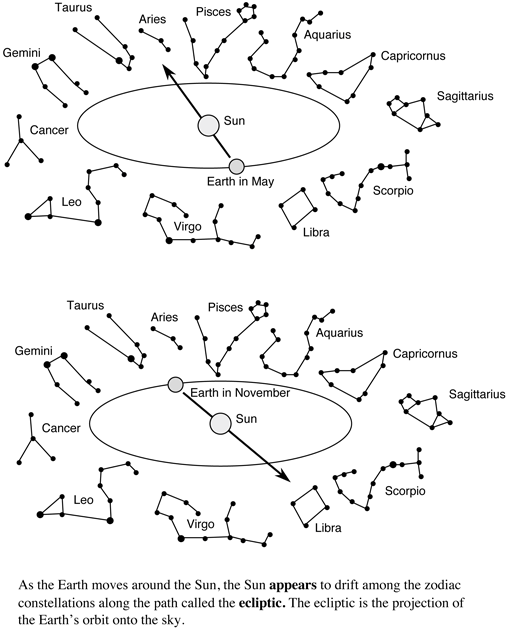
Video lecture for this chapter
Now that you have your bearings, let's take a look at the position and motion of the closest star to us, the Sun. Every day the Sun rises in an easterly direction, reaches maximum height when it crosses the meridian at local noon, and sets in a westerly direction and it takes the Sun on average 24 hours to go from noon position to noon position the next day. The ``noon position'' is when the Sun is on the meridian on a given day. Our clocks are based on this solar day. The exact position on the horizon of the rising and setting Sun varies throughout the year (remember though, the celestial equator always intercepts the horizon at exactly East and exactly West). Also, the time of the sunrise and sunset changes throughout the year, very dramatically so if you live near the poles, so the solar day is measured from ``noon to noon''.
The Sun appears to drift eastward with respect to the stars (or lag behind the stars) over a year's time. It makes one full circuit of 360 degrees in 365.24 days (very close to 1 degree or twice its diameter per day). This drift eastward is now known to be caused by the motion of the Earth around the Sun in its orbit.

The apparent yearly path of the Sun through the stars is called the ecliptic. This circular path is tilted 23.5 degrees with respect to the celestial equator because the Earth's rotation axis is tilted by 23.5 degrees with respect to its orbital plane. Be sure to keep distinct in your mind the difference between the slow drift of the Sun along the ecliptic during the year and the fast motion of the rising and setting Sun during a day.
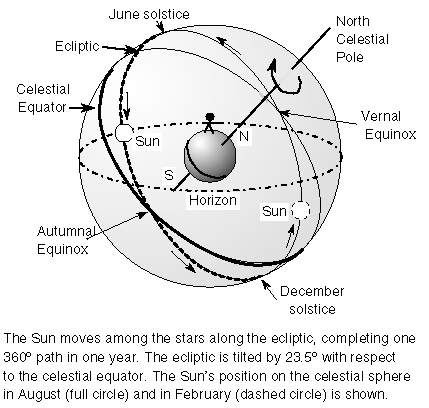
The ecliptic and celestial equator intersect at two points: the vernal (spring) equinox and autumnal (fall) equinox. The Sun crosses the celestial equator moving northward at the vernal equinox around March 21 and crosses the celestial equator moving southward at the autumnal equinox around September 22. When the Sun is on the celestial equator at the equinoxes, everybody on the Earth experiences 12 hours of daylight and 12 hours of night for those two days (hence, the name ``equinox'' for ``equal night''). The day of the vernal equinox marks the beginning of the three-month season of spring on our calendar and the day of the autumn equinox marks the beginning of the season of autumn (fall) on our calendar. On those two days of the year, the Sun will rise in the exact east direction, follow an arc right along the celestial equator and set in the exact west direction.
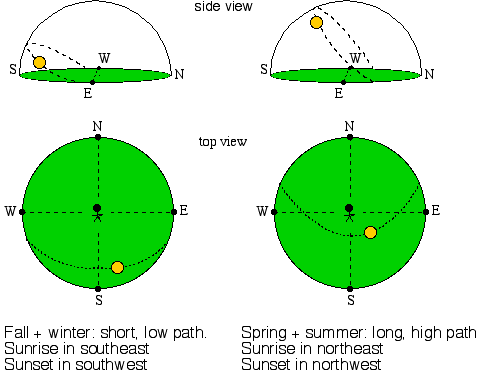
When the Sun is above the celestial equator during the seasons of spring and summer, you will have more than 12 hours of daylight. The Sun will rise in the northeast, follow a long, high arc north of the celestial equator, and set in the northwest. Where exactly it rises or sets and how long the Sun is above the horizon depends on the day of the year and the latitude of the observer. When the Sun is below the celestial equator during the seasons of autumn and winter, you will have less than 12 hours of daylight. The Sun will rise in the southeast, follow a short, low arc south of the celestial equator, and set in the southwest. The exact path it follows depends on the date and the observer's latitude.
Make sure you understand this. No matter where you are on the Earth, you will see 1/2 of the celestial equator's arc. Since the sky appears to rotate around you in 24 hours, anything on the celestial equator takes 12 hours to go from exact east to exact west. Every celestial object's diurnal (daily) motion is parallel to the celestial equator. So for northern observers, anything south of the celestial equator takes less than 12 hours between rise and set, because most of its rotation arc around you is hidden below the horizon. Anything north of the celestial equator takes more than 12 hours between rising and setting because most of its rotation arc is above the horizon. For observers in the southern hemisphere, the situation is reversed. However, remember, that everybody anywhere on the Earth sees 1/2 of the celestial equator so at the equinox, when the Sun is on the equator, you see 1/2 of its rotation arc around you, and therefore you have 12 hours of daylight and 12 hours of nightime everyplace on the Earth.
Select here for animations of the Sun's motion at two different locations on the Earth
The geographic poles and equator are special cases. At the geographic poles the celestial equator is right along the horizon and the full circle of the celestial equator is visible. Since a celestial object's diurnal path is parallel to the celestial equator, stars do not rise or set at the geographic poles. On the equinoxes the Sun moves along the horizon. At the North Pole the Sun ``rises'' on March 21st and ``sets'' on September 22. The situation is reversed for the South Pole. On the equator observers see one half of every object's full 24-hour path around them, so the Sun and every other star is above the horizon for exactly 12 hours for every day of the year.
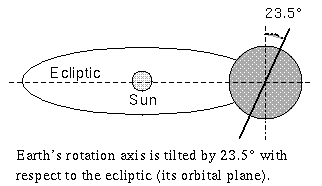 Since the ecliptic is tilted 23.5 degrees with respect to the celestial equator,
the Sun's maximum angular distance from the celestial equator is 23.5 degrees.
This happens
at the solstices. For observers in the northern hemisphere, the farthest
northern point above the celestial equator is the summer solstice, and
the farthest southern point is the winter solstice.
The word ``solstice'' means ``sun standing still'' because the Sun stops moving northward
or southward at those points on the ecliptic. The Sun reaches
winter solstice around December 21 and you see the least part of its diurnal
path all year---this is the day of the least amount of daylight and marks the
beginning of the season of winter for the northern hemisphere.
On that day the Sun rises at its furthest south position in the southeast,
follows its lowest
arc south of the celestial equator, and sets at its furthest south
position in the southwest. The Sun
reaches the summer solstice around June 21 and you see the greatest part of its
diurnal path above the horizon all year---this is the day of the most amount of daylight
and marks the beginning of the season of summer for the
northern hemisphere. On that day the Sun rises at its furthest north position in the
northeast, follows its highest arc north of the celestial equator, and
sets at its furthest north position in the northwest.
Since the ecliptic is tilted 23.5 degrees with respect to the celestial equator,
the Sun's maximum angular distance from the celestial equator is 23.5 degrees.
This happens
at the solstices. For observers in the northern hemisphere, the farthest
northern point above the celestial equator is the summer solstice, and
the farthest southern point is the winter solstice.
The word ``solstice'' means ``sun standing still'' because the Sun stops moving northward
or southward at those points on the ecliptic. The Sun reaches
winter solstice around December 21 and you see the least part of its diurnal
path all year---this is the day of the least amount of daylight and marks the
beginning of the season of winter for the northern hemisphere.
On that day the Sun rises at its furthest south position in the southeast,
follows its lowest
arc south of the celestial equator, and sets at its furthest south
position in the southwest. The Sun
reaches the summer solstice around June 21 and you see the greatest part of its
diurnal path above the horizon all year---this is the day of the most amount of daylight
and marks the beginning of the season of summer for the
northern hemisphere. On that day the Sun rises at its furthest north position in the
northeast, follows its highest arc north of the celestial equator, and
sets at its furthest north position in the northwest.
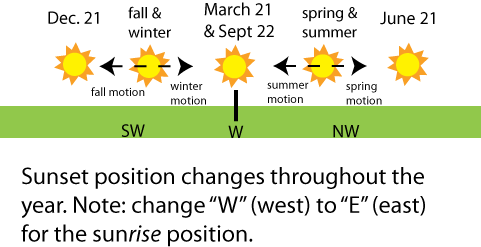
The seasons are opposite for the southern hemisphere (eg., it is summer in the southern hemisphere when it is winter in the northern hemisphere). The Sun does not get high up above the horizon on the winter solstice. The Sun's rays hit the ground at a shallow angle at mid-day so the shadows are long at mid-day. On the summer solstice the mid-day shadows are much shorter because the Sun is much higher above the horizon.
To check your understanding of the concepts in this section (and improve it!), go through the Motions of the Sun module of the University of Nebraska-Lincoln's Astronomy Education program (link will appear in a new window) and use their Motions of the Sun Simulator in the Native Apps package (the Flash simulators no longer work with today's browsers). One section of the module will also cover solar and sidereal time that Astronomy Notes covers in a later section. The module also shows how the shadow lengths and directions change with the position of the Sun throughout the year.
| autumnal (fall) equinox | ecliptic | season |
|---|---|---|
| solar day | summer solstice | vernal (spring) equinox |
| winter solstice |
![]() Go back to previous section --
Go back to previous section --
![]() Go to next section
Go to next section
last updated: January 18, 2022